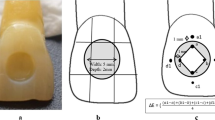Abstract
This study aimed to assess the color stability of two composite resins, unprotected or protected with a hydrosoluble gel (oxygen inhibitor) during final polymerization, when subjected to different staining solutions and daily tooth brushing simulation. Nanohybrid composite (IPS Empress Direct) or nanofilled composite (Filtek Z350) were used to produce round samples that were either unprotected or protected with a hydrosoluble gel before the final cycle of polymerization. For 5 days, the samples were immersed for 1 h/day in four different staining solutions: distilled water (control), coffee, soft drink, and red wine. Once a day, the samples were also subjected to mechanical brushing with soft-bristled brushes for 30 min. The combination of experimental conditions produced 16 groups (n = 10). Color changes (ΔE) were evaluated at baseline and after mechanical brushing cycles for 1, 3, and 5 days. Data were analyzed by linear regression models. Protection with hydrosoluble gel was able to significantly reduce the color change only on the first day (p = 0.001). The type of composite resin did not significantly affect the color change over the days. Wine affected composite resin color change only on the first day (p = 0.002). Over time, color stability of composite resins did not improve with the protection of a hydrosoluble gel before the final polymerization.


Similar content being viewed by others
References
Demarco FF, Collares K, Coelho-De-Souza FH, Correa MB, Cenci MS, Moraes RR, Opdam NJM. Anterior composite restorations: a systematic review on long-term survival and reasons for failure. Dent Mater. 2015. https://doi.org/10.1016/j.dental.2015.07.005.
Can Say E, Yurdagüven H, Yaman BC, Ozer F. Surface roughness and morphology of resin composites polished with two-step polishing systems. Dent Mater. 2014. https://doi.org/10.4012/dmj.2013-287.
Ardu S, Duc O, Di Bella E, Krejci I. Color stability of different composite resins after polishing. Odontology. 2018. https://doi.org/10.1007/s10266-017-0337-y.
Kamonkhantikul K, Arksornnukit M, Takahashi H, Kanehira M, Finger WJ. Polishing and toothbrushing alters the surface roughness and gloss of composite resins. Dent Mater. 2014. https://doi.org/10.4012/dmj.2014-111.
Silva Leite MLA, Medeiros e Silva FDSC, Meireles SS, Duarte RM, Andrade AKM. The effect of drinks on color stability and surface roughness of nanocomposites. Eur J Dent. 2014. https://doi.org/10.4103/1305-7456.137640.
Gauthier MA, Stangel I, Ellis TH, Zhu XX. Oxygen inhibition in dental resins. J Dent Res. 2005. https://doi.org/10.1177/154405910508400808.
Heintze SD, Forjanic M, Ohmiti K, Rousson V. Surface deterioration of dental materials after simulated toothbrushing in relation to brushing time and load. Dent Mater. 2010. https://doi.org/10.1016/j.dental.2009.11.152.
Khalid H, Al-Samadani. The effect of preventive agents (mouthwashes/gels) on the color stability of dental resin-based composite materials. Dent J. 2017. https://doi.org/10.3390/dj5020018.
Nasim I, Neelakantan P, Sujeer R, Subbarao CV. Color stability of microfilled, microhybrid and nanocomposite resins—an in vitro study. J Dent. 2010. https://doi.org/10.1016/j.jdent.2010.05.020.
Maske TT, Brauner KV, Nakan L, Arthur RA, van de Sande FH, Cenci MS. An in vitro dynamic microcosm biofilm model for caries lesion development and antimicrobial dose-responde studies. J Bioadhesion Biofilm Res. 2016. https://doi.org/10.1080/08927014.2015.
Baldissera RA, Corrêa MB, Schuch HS, et al. Are there universal restorative composites for anterior and posterior teeth? J Dent. 2013. https://doi.org/10.1016/j.jdent.2013.08.016.
Yildiz E, Sirin Karaarslan E, Simsek M, Ozsevik AS, Usumez A. Color stability and surface roughness of polished anterior restorative materials. Dent Mater. 2015. https://doi.org/10.4012/dmj.2014-344.
Bijelic-Donova J, Garoushi S, Lassila LV, Vallittu PK. Oxygen inhibition layer of composite resins: effects of layer thickness and surface layer treatment on the interlayer bond strength. Eur J Oral Sci. 2015. https://doi.org/10.1111/eos.12167.
Cenci MS, Venturini D, Pereira-Cenci T, Piva E, Demarco FF. The effect of polishing techniques and time on surface characteristics and sealing ability of resin composite restorations after one-year storage. Oper Dent. 2008. https://doi.org/10.2341/07-66.
Venturini D, Cenci MS, Demarco FF, Camacho GB, Powers JM. Effect of polishing techniques and time on surface roughness, hardness and microleakage of resin composite restorations. Oper Dent. 2006. https://doi.org/10.2341/04-155.
Bagheri R, Burrow MF, Tyas M. Influence of food-simulating solutions and surface finish on susceptibility to staining of esthetic restorative materials. J Dent. 2005. https://doi.org/10.1016/j.jdent.2004.10.018.
Reddy PS, Tejaswi KLS, Shetty S, Annapoorna BM, Pujari SC, Thippeswamy HM. Effects of commonly consumed beverages on surface roughness and color stability of the nano, microhybrid and hybrid composite resins: an in vitro study. J Contemp Dent Pract. 2013. https://doi.org/10.5005/jp-journals-10024-1390.
Ardu S, Duc O, Di Bella E, Krejci I. Color stability of recent composite resins. Odontology. 2017. https://doi.org/10.1007/s10266-016-0234-9.
Paravina RD, Ghinea R, Herrera LJ, Bona AD, Igiel C, Linninger M, Sakai M, Takahashi H, Takashkandi E, Perez MDM. Color difference thresholds in dentistry. J Esthet Restor Dent. 2015. https://doi.org/10.1111/jerd.12149.
Demirci M, Tuncer S, Sancakli HS, Tekçe N, Baydemir C. Five-year clinical evaluation of a nanofilled and a nanohybrid composite in class IV cavities. Oper Dent. 2018. https://doi.org/10.2341/16-358-C.
Acknowledgements
The authors do not have any financial interest in the companies whose materials are included in this article.
Author information
Authors and Affiliations
Corresponding author
Ethics declarations
Conflict of interest
The authors declare that they have no conflict of interest.
Additional information
Publisher’s Note
Springer Nature remains neutral with regard to jurisdictional claims in published maps and institutional affiliations.
Rights and permissions
About this article
Cite this article
Schroeder, T., da Silva, P.B., Basso, G.R. et al. Factors affecting the color stability and staining of esthetic restorations. Odontology 107, 507–512 (2019). https://doi.org/10.1007/s10266-019-00421-x
Received:
Accepted:
Published:
Issue Date:
DOI: https://doi.org/10.1007/s10266-019-00421-x




